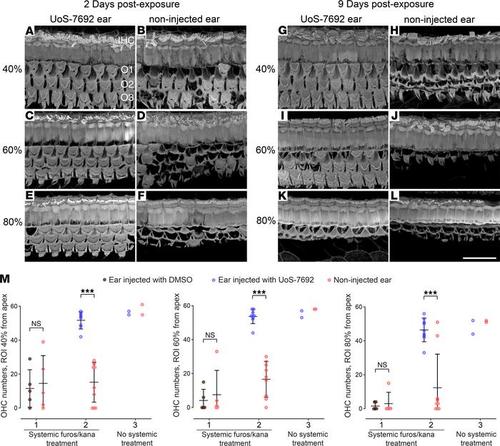Fig. 11
- ID
- ZDB-FIG-210504-11
- Publication
- Kenyon et al., 2021 - Identification of a novel series of hair-cell MET channel blockers that protect against aminoglycoside-induced ototoxicity
- Other Figures
- All Figure Page
- Back to All Figure Page
|
Transtympanic injection of UoS-7692 protects OHCs from systemic kanamycin treatment. (A–L) Assessment of OHC-bundle morphology with phalloidin staining in regions 40% (A, B, G, and H), 60% (C–D, I, and J), and 80% (E, F, K, and L) from the cochlear apex in mice receiving transtympanic injection of UoS-7692 in 1 ear (A, C, E, G, I, and K) and no injection in the opposite ear (B, D, F, H, J, and L), followed by systemic furosemide/kanamycin. Mice were maintained for either 2 (A–F) or 9 (G–L) days. In UoS-7692–treated ears after 2 days, there was minimal or no OHC loss in all regions; in untreated ears, OHC loss was extensive, particularly in the 60% and 80% regions. In UoS-7692–treated ears after 9 days, some OHC loss was observed in the 60% region (I) and total loss seen in the 80% region (K); in untreated ears, there was total loss of OHCs in all regions (H, J, and L). Scale bar: 20 μm. (M) Graphs comparing OHC numbers in cochleae of noninjected (red symbols) and injected (brown and blue symbols) ears of mice 2 days after unilateral transtympanic application of 5% DMSO (brown symbols) or 50 mM UoS-7692 in 5% DMSO (blue symbols), followed by systemic furosemide/kanamycin (groups 1 and 2) or no treatment (group 3). Numbers of mice: group 1 (n = 5), group 2 (n = 9), group 3 (n = 2). OHCs were counted in 140 μm length regions located 40%, 60%, and 80% from the cochlear apex. UoS-7692 provided significant protection in all 3 regions (2-way ANOVA with matched pairs design between cochleae from the same animal, with Šidák’s multiple-comparison test between injected and noninjected ears. ***P < 0.001). Scale bar: 20 μm. Error bars show SDM. |

